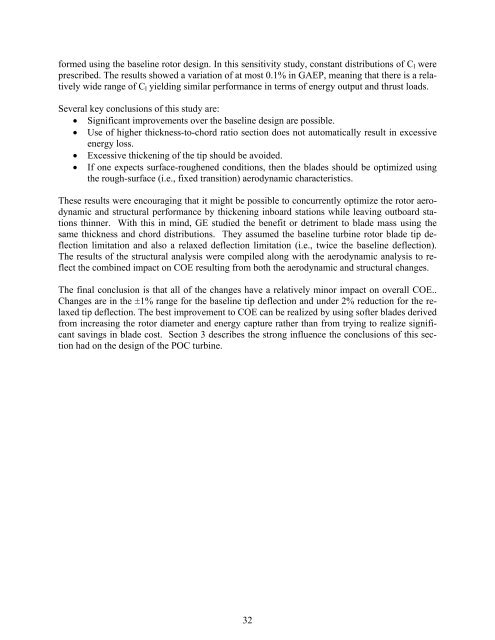Advanced Wind Turbine Program Next Generation Turbine ... - NREL
Advanced Wind Turbine Program Next Generation Turbine ... - NREL
Advanced Wind Turbine Program Next Generation Turbine ... - NREL
You also want an ePaper? Increase the reach of your titles
YUMPU automatically turns print PDFs into web optimized ePapers that Google loves.
formed using the baseline rotor design. In this sensitivity study, constant distributions of Cl were<br />
prescribed. The results showed a variation of at most 0.1% in GAEP, meaning that there is a relatively<br />
wide range of Cl yielding similar performance in terms of energy output and thrust loads.<br />
Several key conclusions of this study are:<br />
• Significant improvements over the baseline design are possible.<br />
• Use of higher thickness-to-chord ratio section does not automatically result in excessive<br />
energy loss.<br />
• Excessive thickening of the tip should be avoided.<br />
• If one expects surface-roughened conditions, then the blades should be optimized using<br />
the rough-surface (i.e., fixed transition) aerodynamic characteristics.<br />
These results were encouraging that it might be possible to concurrently optimize the rotor aerodynamic<br />
and structural performance by thickening inboard stations while leaving outboard stations<br />
thinner. With this in mind, GE studied the benefit or detriment to blade mass using the<br />
same thickness and chord distributions. They assumed the baseline turbine rotor blade tip deflection<br />
limitation and also a relaxed deflection limitation (i.e., twice the baseline deflection).<br />
The results of the structural analysis were compiled along with the aerodynamic analysis to reflect<br />
the combined impact on COE resulting from both the aerodynamic and structural changes.<br />
The final conclusion is that all of the changes have a relatively minor impact on overall COE..<br />
Changes are in the ±1% range for the baseline tip deflection and under 2% reduction for the relaxed<br />
tip deflection. The best improvement to COE can be realized by using softer blades derived<br />
from increasing the rotor diameter and energy capture rather than from trying to realize significant<br />
savings in blade cost. Section 3 describes the strong influence the conclusions of this section<br />
had on the design of the POC turbine.<br />
32
















